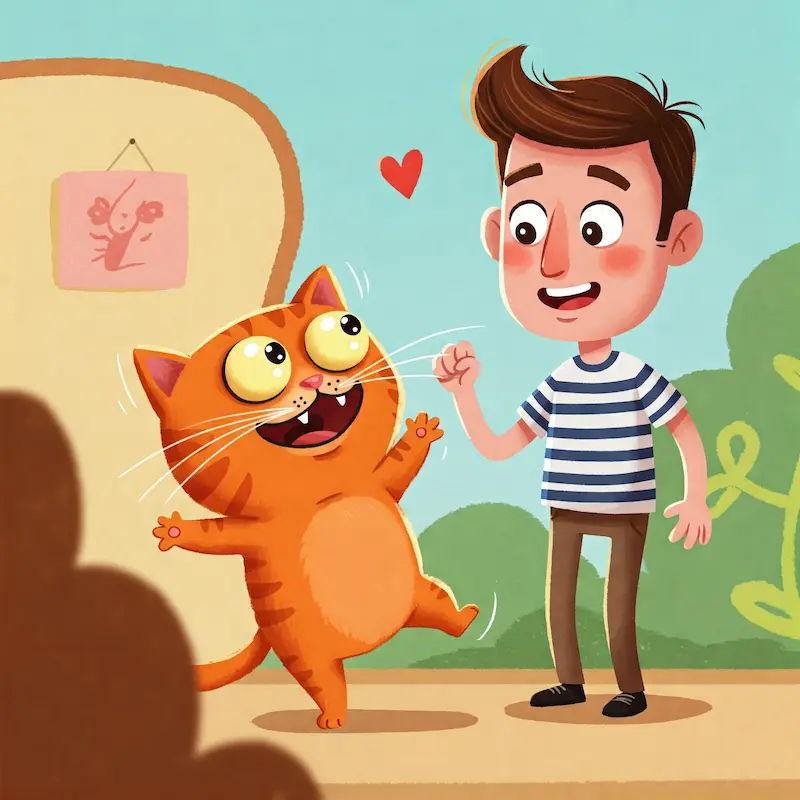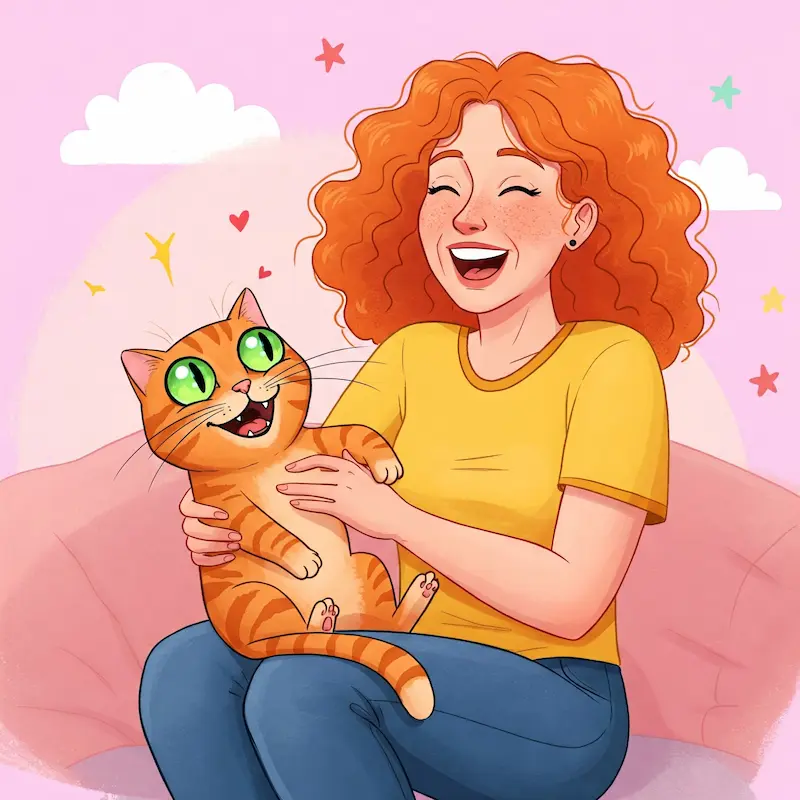Is Your Cat Truly Happy? Find Out with the Quality of Life Tool
A cat health calculator can help you measure your cat's second happiness and health in a simple and clear method. Checking in frequently can catch small changes in your cat that could indicate boredom, loneliness, or discomfort. In particular, you may use the above perceptions to make their daily routine more pleasant, more healthy, and more fulfilling.
In This Article
Understanding Feline Quality of Life

The well-being of a cat goes beyond just its physical health. It includes safety, functionality, diet, environment, and emotional happiness. A cat thrives when all these aspects are in harmony.
Keep an eye out for these important sections:
- Is your cat eating well and maintaining a healthy weight?
- Is your cat able to move easily?
- Does your cat seem interested, play often, and respond to unfamiliar experiences?
- Is the environment adequate in terms of space, safe hiding places, rest areas, and opportunities for physical activity?
- Does your cat like being around you, playing, or grooming with other cats?
Veterinarians and animal behavior experts both agree that keeping an eye on these traits is key to making sure that your cat stays happy, especially as they get older or deal with health issues.
Using a cat health calculator can help you track your cat's information over a long period of time.
Key Indicators of a Happy Cat
Happy cats usually hide behind a little while revealing a sign. Pay attention, because these mannerisms can prove your cat's content every day.
- Purring and kneading: Cats purr when relaxed and knead when they feel safe or affectionate.
- Curiosity and play: Healthy cats like to explore, chase toys, and interact with people.
- Self-grooming: Regular grooming points to both comfort and health.
- Good appetite: Consistent eating habits often reflect well-being.
- Relaxed body language: Ears forward, tail upright or gently waving, and loose posture signal happiness.
Trying to get attention, a lot of cats show affection by bumping heads, following you, or sitting on your lap.
On the other hand, signs of distress may appear as concealment, aggression, loss of appetite, or otherwise excessive singing. Descry in such a timely manner can make a real difference.
Why Assessing Quality of Life Matters
Tracking your cat's health helps you spot health problems before they become serious. Small changes, such as a change in the engagement habit or appetite, can cause pain, boredom, or stress. Regular quality assurance checks bridge the gap between routine inspections and competent veterinary advice.
Benefits include:
- Early detection of illness or discomfort
- Stronger bonds built on better understanding
- Adjustments to routine that bring more ease and happiness to your cat’s days
- Confidence when making big decisions about care, especially for elderly or chronically ill cats
You are supporting your cat's emotional and material needs, which are close to every life grandstand, by taking a regular look at your quality of life.
Using a Cat Quality of Life Calculator

The Cat Health Calculator is a simple, synergistic tool that helps you assess the health of your cat. It asks you to measure several aspects of your cat's second life, such as pain, appetite, sterility, and interactions clearly. The current technique takes the guesswork out of knowing what your cat's other needs are.
These calculators focus on:
- Comfort and absence of pain
- Joy and mental stimulation
- Mobility and energy levels
- Appetite and hydration
- Hygiene and grooming ability
- Social needs and emotional state
You can get a badge that shows your cat in the whole picture by evaluating the area in question from poor to excellent.
Step-by-Step Guide to Evaluating Your Cat
- Preparation for the assessment: Select a quiet moment, free from distractions, when your cat will be able to demonstrate its natural behavior.
- Observe carefully: Watch your cat closely. Communication is based on habit, movement, education, and fascination for the surroundings.
- Score each area: Use a scale of 1 to 10 for an honest evaluation of each individual item.
- Repeat regularly: Use the tool monthly or whenever you are concerned about changes in your cat's behavior.
Remember: this tool supports your observations but doesn’t replace your vet’s advice.
Interpreting Results and Next Steps
Your cat's probably going to thrive, a wonderful sign that you can stand up to the usual thoughtfulness and maintain your excellent function. If the mark is in the center or diminished, it probably means that you need to modify your routine or consult your doctor.
After using the calculator:
- Celebrate strengths, like good appetite or playful mood.
- Address weaknesses, such as limited movement or poor grooming, right away.
- Keep a log to track any trends or sudden drops in scores.
- For persistent or severe problems, especially in cases of secondary pain, weight loss, or withdrawal, consult your veterinary surgeon.
The obvious consequences empower you to perform alongside trust, whether that means more play, a health check, or a more comfortable change.
Practical Ways to Improve Your Cat’s Happiness
Improving your cat's quality of life doesn't have to be complicated. By focusing on their environment, diet, and the bond you share, you can help your feline friend stay healthy and happy. Let's explore three key areas that can bring joy and comfort to your cat's daily life.

When you use a health checklist, you probably want to increase your cat's everyday joy and reassure yourself. Your cat's mood and health can be greatly affected by small changes.
Actionable ideas include:
- Refreshing the play area or adding cozy bedding
- Rotating toys and providing daily interactive games
- Improving litter box hygiene
- Offering new flavors or foods suitable for your cat
If you are looking to improve your diet, you might find value in a dedicated calculator to assist you with robust alternatives. Check the Cat Calorie Calculator for advice on how to feed your cat properly.
Environmental Enrichment and Play
Cats crave variety and adventure—even indoors. Here’s how to keep things interesting:
- Add window perches for bird-watching
- Provide scratching posts and climbing trees
- Rotate puzzle toys to spark curiosity
- Install shelves or hideaways for climbing and rest
- Use safe indoor plants or cat grass to mimic outdoor textures
A regular, restful walk, even a few minutes, can brighten your cat's day and help you build a chemical bond.
Optimizing Nutrition and Health
Nutrition plays an important role in a happy, active cat. There are specific requirements for each life stage and health condition. A balanced diet should provide complete nutrition without excessive calories.
Help yourself with external analytical tools like a Cat Carb Calculator to determine the amount of carbohydrates in your cat’s diet. Stay current with regular veterinary visits, annual check-ups, and prompt attention to weight, dental care, and any behavior changes.
Always check that new food is safe before introducing it. Consult a reliable Can Cats Eat Guide to ensure unfamiliar snacks are both diverse and safe.
Conclusion
The true happiness of your cat starts with careful observation and honest evaluation. A quality of life calculator reveals subtle issues that might otherwise go unnoticed, helping you care for your cat each day.
By regularly checking in, adapting routines, and seeking expert advice when needed, you give your cat a life full of companionship, activity, and love.
Use a health tool to reinforce your bond, detect subtle changes, and guide your choices. Every action you take toward your cat’s well-being strengthens the lasting relationship you share.
Quality of Life Calculator FAQ
- What is the Quality of Life Calculator?
- The Quality of Life Calculator is a tool designed to help you assess your cat's overall happiness and well-being. It evaluates factors like daily behavior, energy levels, appetite, and comfort to give you insights into how your cat feels.
- Is the calculator based on veterinary guidelines?
- Yes, it’s informed by general veterinary practices, though it’s not a substitute for advice from your vet. It’s meant to give you a better understanding of your cat’s quality of life, but professional evaluations are always recommended for medical concerns.
- Can I use this tool for senior cats?
- Absolutely. The calculator can be especially helpful for aging cats, as it helps identify changes in their behavior or comfort that might require attention.
- Can this tool help me spot health problems?
- While it’s not a diagnostic tool, it can highlight areas where your cat might be struggling, like reduced activity or changes in appetite, which could indicate underlying issues. It’s a good starting point for discussing concerns with your vet.
References
CatsLib.com relies on trusted, high-quality sources, including peer-reviewed research, to back the information in its articles. We regularly review and update our content to ensure it remains accurate and reliable.
If you have concerns about your pet's health or any medical questions, we highly recommend consulting a qualified veterinarian. The information on this site is for general informational purposes only and should not be used as a substitute for professional advice, diagnosis, or treatment.
How We Ensure Accuracy
At CatsLib, we take the accuracy of the information we provide very seriously. Our content is created and reviewed by experts to ensure that every piece of advice is not only helpful but also based on the latest veterinary research. Here’s how we make sure the information you read is reliable:
- ✔ Content reviewed by certified experts
- ✔ Based on up-to-date veterinary research
- ✔ Reviewed regularly for relevance and accuracy
Recent Articles

Why Are Siamese Cats Cross Eyed? Genetics, Health, and Care Guide

Do Ragdoll Cats Shed a Lot? Seasonal Tips to Manage Fur and Keep Your Home Clean

10 Medical Reasons Your Cat Is Walking in Circles – Signs You Should Never Ignore

Why Does Your Cat Scratch Around Its Food Bowl? Top Reasons and Simple Solutions
